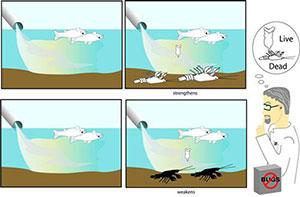Verified Predictions
Concept
Verified Predictions: Knowledge of a cause's mode of action permits prediction and subsequent confirmation of previously unobserved effects.
 Figure 3-10. Verified Predictions.
Figure 3-10. Verified Predictions.
Click here for more information
Examples
Consider organophosphate pesticides as a candidate cause of reduced aquatic insect abundance. What findings support or weaken the case for these pesticides as the cause, based on evidence garnered from predicted effects?
- Supporting evidence - Monitoring data show that other taxa sensitive to cholinesterase inhibitors (e.g., crayfish) have declined at the impaired site, while taxa without cholinergic receptors (e.g., rotifers) have not been adversely affected.
- Weakening evidence - Monitoring data show that taxa predicted to decrease with exposure to organophosphates are not reduced at the impaired site, whereas taxa predicted to be unaffected have declined.
How Do I Analyze the Data?
Prediction requires knowledge of effects that occur with particular causes. If other candidates may cause the effect, successful prediction of the effect is only weakly supportive. The prediction may involve evidence of temporal sequence, spatial/temporal co-occurrence, stressor-response relationships, exposure or mechanism, causal pathway, or manipulations. For this reason, special care should be taken to avoid biasing the analysis by using the same evidence more than once. This type of evidence can greatly strengthen the case for a candidate cause, if it truly results from a prediction, because predictions are based on a deeper knowledge of mechanisms driving potential cause-effect interactions.
The logical constraints and statistical tests appropriate for analysis of predictions depend on the nature of the prediction or the type of evidence the prediction addresses; these issues have already been discussed under previous types of evidence from the case.
What Evidence Would Support or Weaken the Case for a Candidate Cause?
- Data showing that a predicted, previously undocumented effect is observed at the impaired site
- Data showing that a predicted, previously undocumented effect is not observed at the impaired site
- Data showing, with a high degree of certainty, that a predicted obligatory effect does not occur at the impaired site
How Do I Score the Evidence?
| Finding | Interpretation | Score |
|---|---|---|
| Specific or multiple predictions of other effects of the candidate cause are confirmed. | This finding convincingly supports the case for the candidate cause, because predictions confirm a mechanistic understanding of the causal relationship, and verification of a predicted association is stronger evidence than associations explained after the fact. | +++ |
| A general prediction of other effects of the candidate cause is confirmed. | This finding somewhat supports the case for the candidate cause, but is not strongly supportive because another cause may be responsible. | + |
| It is unclear whether predictions of other effects of the candidate cause are confirmed. | This finding neither supports nor weakens the case for the candidate cause. | 0 |
| A prediction of other effects of the candidate cause fails to be confirmed. | This finding somewhat weakens the case for the candidate cause, but is not strongly weakening, because other factors may mask or interfere with the predicted effect. | - |
| Multiple predictions of other effects of the candidate cause fail to be confirmed. | This finding convincingly weakens the case for the candidate cause. | --- |
| Specific predictions of other effects of the candidate cause fail to be confirmed, and the evidence is indisputable. | This finding refutes the case for the candidate cause. | R |
Helpful Tips
- Laboratory tests cannot be used to refute toxic effects in the field, due to differing field and laboratory conditions.
- Absence of toxicity in laboratory experiments may be due to more acute, episodic exposures in the field, or to observed biological effects based on species, life stages, or responses that are more sensitive than those used in the laboratory.
